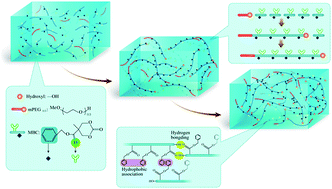Highly efficient self-healing materials with excellent shape memory and unprecedented mechanical properties†
Abstract
Enhancing the mechanical properties and improving the self-healing efficiency are intractable challenges that self-healing materials still need to solve today. In this study, novel dual-physical cross-linked network elastomers with shape memory are designed by introducing dynamic non-covalent bonds via the bulk ring-opening polymerization to improve the mechanical and self-healing properties. The maximum storage modulus and tensile strength of elastomer P4 are 225.82 ± 2.23 MPa and 15.49 ± 0.9 MPa, respectively. Mooney–Rivlin equation calculations indicate that hydrogen bonds and hydrophobic associations play essential roles in reinforcing the mechanical performance and improving the self-healing ability of the elastomers. Meanwhile, elastomer P2 can self-heal after 3 h at room temperature, with a healing efficiency of 95.32%, without requiring any external stimuli. Furthermore, the elastomers present a quick response to body temperature due to the introduction of dynamic non-covalent bonds, resulting in excellent shape memory behavior, and the maximum shape recovery efficiency reaches 72.02 ± 6.94% after 10 s at 37 °C. Further research on the shape recovery time shows that the elastomer can completely recover its original shape after 39.67 ± 1.25 s, indicating a highly efficient shape memory, which offers new directions for future body-sensors, stimuli-responsive materials and wound healing.



 Please wait while we load your content...
Please wait while we load your content...